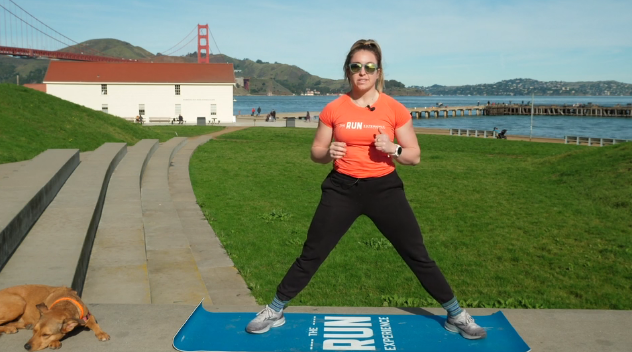Welcome to Quick Start Guide
Quick Start | Week 1
Week 1
“The miracle isn’t that I finished. The miracle is that I had the courage to start.” – John Bingham
Good running can quickly turn to great running when you inject our approach towards warming up, practice these simple techniques, and focus on these running ideas.
You’ll combine these workouts into three types of days this week:
- Running and Mobility
- Strength and Mobility
- Mobility and Rest
As much as your schedule allows, you should try to workout 4-5 days, alternating running and strength with rest days inserted where you need them. Because we’re such big believers in the power of improved mobility, we recommend you do the mobility challenge every day – you won’t regret it!
When you get down to the exercise sections, we’ll give more specific guidance about how to do or adapt the current exercise based on what your goals are. You can do this.
If my goal is ...
what should I
focus on?
- I'm training for a race
Hit the Ground Running
You’re rarin’ to go, but we don’t want to let the horses run free quite yet. The Nose Breathing Mile is deceptively hard but has an important lesson to teach you about connecting your breathing with your running. You may have to start out slower than you expect at first, but it’ll pay dividends. Focus and execute the drills. Challenge yourself to get a little better every day.
- I'm here to get fit and healthy
Spread Your Wings and Explore
There’s a lot to play with here, much of which may be new to you. Take your time and explore the drills and how they feel in your body. The Nose Breathing mile is a curiosity to many, and it can be quite the revelation when you discover something as seemingly simple as breathing has a profound effect on your running.
The same can be said about the squat hold and what it can tell you about where your body’s flexibility is. And nobody does core and strength work quite the way The Run Experience does. Enjoy the challenge!
- Help me... I'm injured
Do What You Can
It’s never fun not being able to run, we get it. With the right perspective, there’s a way to find something beneficial in every exercise regardless of your current physical limitation.
For example, the Nose Breathing Mile exercise can be done on a bike, rower, walking etc. and REALLY HELPS your breathing & run form when your body’s ready to get back to it. Or if something has you off your feet, just try sitting in a chair or on the floor and breathing only through your nose.
As basketball coaching legend John Wooden said, “Never let what you can’t do interfere with what you can.” Injuries don’t last forever, the one you’re currently experiencing included. We’ll help you get through this and come out on the other end stronger.
Get Moving
- Warm Up: Leg Swings + Hip Circles, Arm Circles + Arm Swings
The video at the top of the page shows a simple series of movement designed to wake you up and improve range in your hips, ankles, and shoulders will pay dividends in the form of silky smooth running afterward.
Training for a Race
Run 5-10 minutes relaxed. Stop and do the warm up to get ready for any workout or race!
Get Fit & Healthy
Walk 5-10 minutes or run 1-3 minutes, walk 1 min for 10 minutes. Stop and do the warm up to open up your hips and shoulders and making running feel fluid and good!
Injured
Walk 5-10 minutes or cross-train on a bike, rower, etc. Stop and do the warm up to improve your range of motion, balance, and your mechanics. This will keep you moving and coming back stronger.
- Run Workout: The Nose Breathing Mile!
Your ability to fully breathe into your diaphragm is crucial for your ability to run tall with good posture while dynamically stabilizing your hips with every step to prevent collapse and the injuries that come with it. Nose breathing is an effective way to begin an all-important conversation about breathing deep into your belly.
Training for a Race
Run 1 mile as quickly as you can while still breathing through your nose. This exercise strengthens your diaphragm and your ability to breathe deeply and smoothly when it counts the most – in those final miles to the finish line!
Get Fit & Healthy
Run if you can and take walk breaks if needed, but the goal is to complete 1 mile without breathing through your mouth. The first step to becoming a better athlete and runner is to master your breathing. You’ve got this!
Injured
You may not be able to run at all right now. Fortunately, you can do this breathing exercise while doing anything, so target 8-10 challenging minutes on a bike or rower or stair climber.
Strength Workout
- Our Strength Workout Philosophy
These movements seem simple at first but there is, in fact, a lot going on beneath the surface. In fact, these movements will tell you a lot about your body’s ability to run well without getting injured.
Unless you got hit by a taxi cab, most running injuries don’t come out of “nowhere”. They’re simply an accumulation of crappy mechanics and poor movement patterns that wears your body down.
For the majority of runners, alternating running with riding the office chair, car seat, or couch while way better than nothing, doesn’t give you the strength, coordination, and range of motion to run really well, for long distances, at faster speeds, without getting injured.
- Core: Hollow Body Hold
Training for a Race
Accumulate 3 minutes of a hollow body hold. Short rests as needed. Racers with poor core strength tend to lose form – and a lot of speed – when fatigue sets in. The hollow body builds postural strength and spinal stability and shows you exactly where your failure point is.
Get Fit & Healthy
2 to 4 repetitions of 30 seconds each with 30 seconds rest in between. A strong core not only makes you look and feel good, it makes running feel smoother and lighter all around!
Injured
2 to 4 repetitions of 1 minute each with 30 seconds rest in between. Can you breathe while under tension, and can you make adjustments to ensure that low back is pressed to the ground? This ability to think and breathe while uncomfortable builds your awareness around your movement – and creates a foundation for healthier run mechanics.
- Squat & Pushup Couplet: 1 of each, 2 of each, 3 of each, ...
Ascend a ladder of repetitions for each movement. Start at 1 of each, then 2 of each, working up as many as you can in a 5 minute period. Focus on good depth in each movement and quality and consistent reps!
Start your timers and let’s get moving!
Training for a Race
As many rounds as possible in 5 minutes. Extend to 10 minutes over the next two weeks. Push your intensity while maintaining good form. When and where do you start to fall apart? Thinking about and improving your form in this exercise translates into your ability to run with better form when you’re most fatigued – the end of the race!
Get Fit & Healthy
Keep moving for the 5 minutes, short or no rest breaks. Extend to 8 minutes over the next two weeks. This ascending ladder is tough, and it’ll show you the limits of your strength quickly. But don’t worry. With regular practice your strength will come, and so will improved running!
Injured
Move continuously for 5 minutes – with absolutely no bad form. Extend to 10 minutes over the next two weeks. If form breaks, can you modify the exercise on the go? If not, can you rest long enough to get your form back? Most runners get injured because of a “hole” in their athletic foundation – whether it’s a muscle that’s not firing, or a side that is imbalanced, or the fact that your body is not strong and stable enough. This workout addresses those issues in addition to keeping you fit while you cannot run.
- Tutorial: How To Squat!
Follow these simple steps to not only squat better, but squat in a way that translates to better movement, and better running!
- Tutorial: How to Do a Proper Pushup!
You better believe it! Runners do need *some* upper body strength and no exercise is more effective in achieving this goal than the pushup. Still, there’s a lot going on underneath the surface, so watch this video closely to make sure you’re following all the important steps!
Improve Mobility
- The Squat Challenge
Do the squat challenge after both the run workout and the strength workout this week. How long can you sit in the bottom of a squat pain-free? 1 minute, 3 minutes…10 minutes?
Want to see real change? Try it the next 7 days in a row for a “perfect” week 1 score!
Training for a Race
2-3 minutes minimum per day. The harder you train, the more daily work your body needs to aid in its recovery. Consider the squat challenge the *king* of all mobility exercises – and one that will open up those hips and ankles the most.
Get Fit & Healthy
1-2 minutes. Running is only half the battle to being healthy and fit. You want to increase your body’s natural range of motion too so that you can run – and move – pain free!
Injured
3 -5 minutes minimum per day. We all have some asymmetry or tight area of the body – that when punished with enough mileage – will compensate, fall out of alignment, and turn into an ugly frustrating overuse injury. But fear not! The squat challenge is the perfect self-assessment tool to see where your body measures up, and what you need to do next to get back to health.
Use this ‘exercise’ as an assessment tool! Are your tight, stiff ankles refusing to bend, forcing you onto the balls of your feet? Do your feet turn out and your ankles collapse? Perhaps it’s stiffness in your knees and hips that prevent you from squatting deep without feeling pain or without rounding your back.





